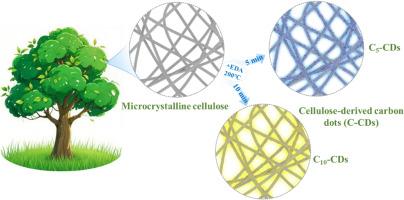用于白光led的抗自猝灭纤维素衍生固态发射碳点的快速一步合成
IF 4.2
3区 工程技术
Q2 CHEMISTRY, APPLIED
引用次数: 0
摘要
采用超快(5 min或10 min)的一锅水热反应合成了纤维素衍生的碳点(C5-CDs和C10-CDs),具有抗聚集猝灭和高效的固态荧光特性。对C-CDs的结构组成和光学性质的详细研究表明,纤维素纳米原纤维的存在有效地抑制了碳芯之间的π-π相互作用。石墨结构中的sp2杂化碳芯产生蓝色荧光。进一步碳化后,在石墨化碳核(给体)和分子荧光团(受体)之间发生荧光共振能量转移。增强的n-π *电子跃迁导致表面态主导的黄绿色发射。利用密度泛函理论进行的模拟证实,石墨N和CO键的增加减少了能带隙,从而促进了更长的波长发射。采用蓝色(C5-CDs)和黄绿色(C10-CDs)的C-CDs作为颜色转换层,生产出具有接近理想白光(CIE 1931坐标(0.33,0.33)和显色指数>;80)的白色发光二极管(WLED)。因此,光显示了被照亮物体的真实颜色。该策略实现了超短反应时间(≤10分钟)和高固体量子产率(40%),为具有成本效益的生物质衍生碳点生产建立了可行的途径。本文章由计算机程序翻译,如有差异,请以英文原文为准。

Rapid one-step synthesis of self-quenching-resistant cellulose-derived solid-state emissive carbon dots for white LEDs
Cellulose-derived carbon dots (C-CDs), namely C5-CDs and C10-CDs, were synthesized via an ultrafast (5 or 10 min) one-pot hydrothermal reaction, exhibiting anti-aggregation-caused quenching and highly efficient solid-state fluorescence. Detailed studies on the structural composition and optical properties of the C-CDs showed that the presence of cellulose nanofibrils effectively inhibits π-π interactions between the carbon cores. The sp2 hybridized carbon cores within the graphitic structure result in blue fluorescence. After further carbonization, fluorescence resonance energy transfer occurs between the graphitized carbon cores (donors) and molecular fluorophores (acceptors). The enhanced n-π∗ electronic transitions lead to surface state-dominated yellow-green emission. Simulations using density functional theory confirmed that increased amounts of graphitic N and C![]() O bonds reduce the energy bandgap and thus promote longer wavelength emission. White light-emitting diodes (WLED), with near ideal white light (CIE 1931 coordinates (0.33, 0.33) and color rendering index >80) were produced using the blue- (C5-CDs) and yellow-green-emitting (C10-CDs) C-CDs as the color-conversion layer. The light, therefore, shows the true colors of illuminated objects. This strategy, which achieves ultra-short reaction times (≤10 min) and high solid-state quantum yields (40 %), establishes a viable pathway for the cost-effective production of biomass-derived carbon dots.
O bonds reduce the energy bandgap and thus promote longer wavelength emission. White light-emitting diodes (WLED), with near ideal white light (CIE 1931 coordinates (0.33, 0.33) and color rendering index >80) were produced using the blue- (C5-CDs) and yellow-green-emitting (C10-CDs) C-CDs as the color-conversion layer. The light, therefore, shows the true colors of illuminated objects. This strategy, which achieves ultra-short reaction times (≤10 min) and high solid-state quantum yields (40 %), establishes a viable pathway for the cost-effective production of biomass-derived carbon dots.
求助全文
通过发布文献求助,成功后即可免费获取论文全文。
去求助
来源期刊

Dyes and Pigments
工程技术-材料科学:纺织
CiteScore
8.20
自引率
13.30%
发文量
933
审稿时长
33 days
期刊介绍:
Dyes and Pigments covers the scientific and technical aspects of the chemistry and physics of dyes, pigments and their intermediates. Emphasis is placed on the properties of the colouring matters themselves rather than on their applications or the system in which they may be applied.
Thus the journal accepts research and review papers on the synthesis of dyes, pigments and intermediates, their physical or chemical properties, e.g. spectroscopic, surface, solution or solid state characteristics, the physical aspects of their preparation, e.g. precipitation, nucleation and growth, crystal formation, liquid crystalline characteristics, their photochemical, ecological or biological properties and the relationship between colour and chemical constitution. However, papers are considered which deal with the more fundamental aspects of colourant application and of the interactions of colourants with substrates or media.
The journal will interest a wide variety of workers in a range of disciplines whose work involves dyes, pigments and their intermediates, and provides a platform for investigators with common interests but diverse fields of activity such as cosmetics, reprographics, dye and pigment synthesis, medical research, polymers, etc.
 求助内容:
求助内容: 应助结果提醒方式:
应助结果提醒方式:


